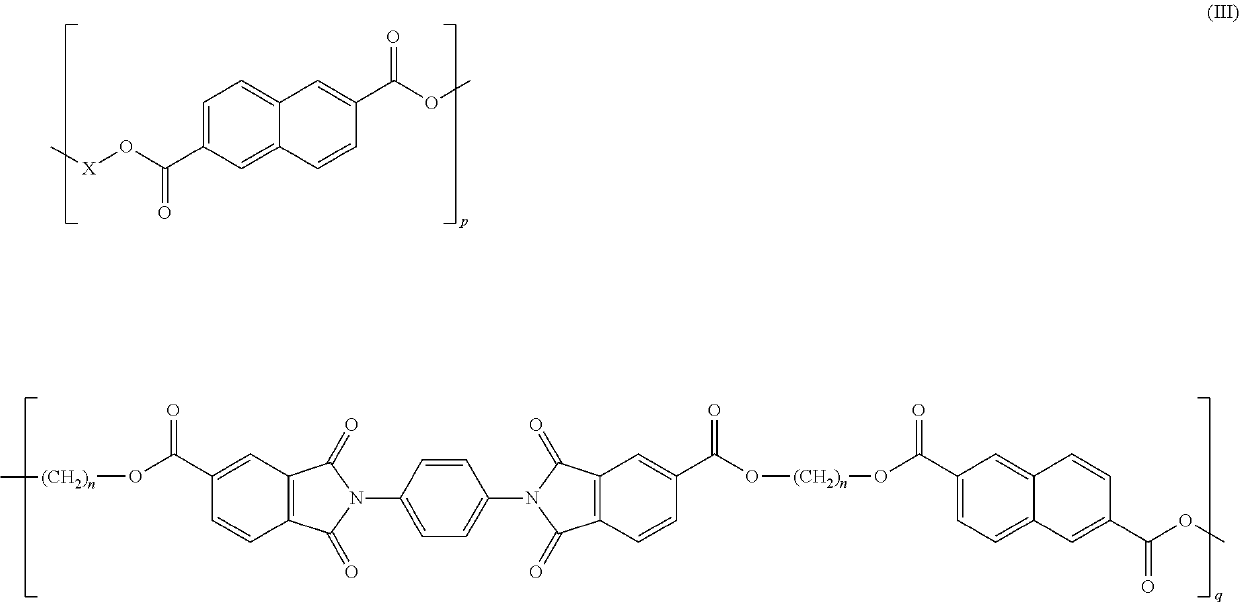Copolyesterimides comprising bis(2-hydroxyalkyl)-2,2′-(1,4-phenylene)bis(1,3-dioxoisoindoline-5-carboxylate) and articles made therefrom
a technology of copolyesters and aromatic carboxylic acids, which is applied in the field of new aromatic carboxylic acid copolyesters, can solve the problems of high crystalline melting point, low tm and/or crystallinity, and inability to manufacture biaxially oriented films. achieve the effect of increasing the tg of said polyester without significantly decreasing tm and/or crystallinity, and not significantly decreasing the tm and/or crystallinity
- Summary
- Abstract
- Description
- Claims
- Application Information
AI Technical Summary
Benefits of technology
Problems solved by technology
Method used
Image
Examples
example 1
Synthesis of Bis(2-hydroxyethyl)-2,2′-(1,4-phenylene)bis(1,3-dioxoisoindoline-5-carboxylate) (PDOIC; Monomer of Formula I)
[0103]A solution of p-phenylene diamine (5.40 g, 50.00 mmol) in DMF (250 mL) was added dropwise to a refluxing solution of 1,2,4-benzenetricarboxylic anhydride (19.20 g, 100.00 mmol) in DMF (50 mL) over 30 mins. The solution was refluxed for a further 1 h, cooled to room temperature, filtered, washed with distilled water and dried in vacuo at 110° C. for 24 h. The intermediate PDOIC product (19.04 g, 83%) was then ground into a fine powder. The intermediate PDOIC product (5.00 g, 10.96 mmol) was dissolved in DMF (100 mL). 2-bromoethanol (4.11 g, 32.87 mmol) and triethylamine (3.33 g, 32.87 mmol) were then added to the solution and the reaction was held at 70° C. for 16 h. The solution was cooled to room temperature and suspended in distilled water, filtered, washed with acetone and dried in vacuo at 110° C. for 24 h. The PDOIC product (3.78 g, 63%) was then groun...
examples 2 to 9
Synthesis of the Copolyesters
[0110]Two series of novel linear poly(ester-imide)s were synthesized by polycondensation between either bis-(2-hydroxyethyl)-terephthalate (BHET) or bis-(2-hydroxyethyl)-2,6-naphthalate (BHEN) and the comonomers of formula (I), in molar amounts of comonomer from about 5 to about 30 mol %. Copolymers containing varying amounts of co-monomer were obtained using Sb2O3 as catalyst. The general polyesterification procedure is as follows, wherein the amounts of reactants used are provided in Tables 1 and 2. A stirred mixture of ester comonomer, PDOIC and Sb2O3 (0.10 g, 0.34 mmol) was poured into a PC rig tube. The PC rig tube was lightly scored on the stem using a Stanley blade to ensure safe extrusion and clamped inside a heating block. After being fitted with a polycondensation head, stirrer guide, air stirrer, delivery side arm, distillate tube inside an ice-filled Dewar flask, thermocouples, optical revolution counter and connected to a gas manifold, the t...
PUM
| Property | Measurement | Unit |
|---|---|---|
| degree of crystallinity | aaaaa | aaaaa |
| haze | aaaaa | aaaaa |
| haze | aaaaa | aaaaa |
Abstract
Description
Claims
Application Information
 Login to View More
Login to View More - R&D
- Intellectual Property
- Life Sciences
- Materials
- Tech Scout
- Unparalleled Data Quality
- Higher Quality Content
- 60% Fewer Hallucinations
Browse by: Latest US Patents, China's latest patents, Technical Efficacy Thesaurus, Application Domain, Technology Topic, Popular Technical Reports.
© 2025 PatSnap. All rights reserved.Legal|Privacy policy|Modern Slavery Act Transparency Statement|Sitemap|About US| Contact US: help@patsnap.com



